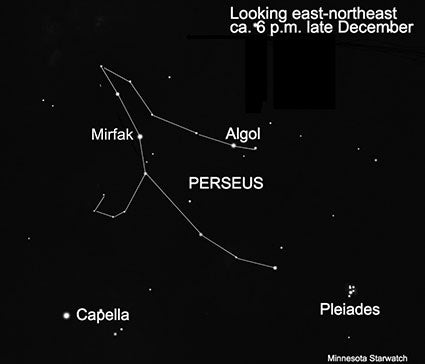Minnesota Star Watch: A trio of gods in the atmosphere on Dec. 3
Published 5:35 am Saturday, November 30, 2019
By Deane Morrison
A University of Minnesota feature
December opens with Jupiter dropping into the sunset. On the 3rd, Saturn, Venus and Jupiter form a diagonal line with Jupiter in the sun’s afterglow and brilliant Venus almost exactly midway between the other two planets.
As Jupiter sinks, Venus climbs. In the second week of the month, Venus passes much dimmer Saturn, coming closest on the 10th and 11th. On the 28th, Venus comes out above a thin young crescent moon; together, they form a celestial semicolon.
In the east, the knot of bright winter stars assembles for viewing by about 10:30 p.m., earlier as the month goes on. If you have a lot of nights with clear, dark skies, try locating the constellation Perseus (a star chart will really help). Find the brilliant star Capella at the top of the winter assembly and look to the right to find the Pleiades star cluster. Then look at the space immediately above and between them. You’ll see scraggly Perseus and its brightest star, Mirfak. Slightly lower and to the right of Mirfak is Algol, the constellation’s second-brightest star, whose name comes from the Arabic for “the demon.”

Minnesota Star Watch
The “Demon Star’s” brightness varies noticeably every two days, 20 hours and 49 minutes. That’s because Algol is a triple star, and when a dimmer one passes in front of the brightest one, we see a dip in brightness. Algol was regarded as the winking eye of Medusa, the snake-haired monster slain by the mythical Greek hero Perseus.
In the predawn sky, Mars is dim but climbing steadily in the southeast. To find it, try looking an hour before sunrise on the 23rd, when a thin crescent moon appears below and left of the red planet. Near the end of the month, the stars of Scorpius approach Mars as they crawl up from the horizon. Among them is the heart of the scorpion: reddish Antares, whose name means “rival of Mars.” Antares will pass Mars in January. The star is currently brighter than Mars, but in October 2020, when Earth laps Mars in the orbital race, the red planet will far outshine its rival.
December’s full moon rises the evening of the 11th. Ten days later, at 10:19 p.m. on the 21st, the winter solstice arrives. At that moment the sun reaches a point directly over the Tropic of Capricorn, marking the official start to winter in the Northern Hemisphere.
The University of Minnesota offers public viewings of the night sky at its Duluth and Twin Cities campuses. For more information and viewing schedules, see:
- Duluth, Marshall W. Alworth Planetarium: www.d.umn.edu/planet
- Twin Cities, Minnesota Institute for Astrophysics: www.astro.umn.edu/outreach/pubnight
Check out astronomy programs, free telescope events, and planetarium shows at the University of Minnesota’s Bell Museum: www.bellmuseum.umn.edu/astronomy
Find U of M astronomers and links to the world of astronomy at www.astro.umn.edu

